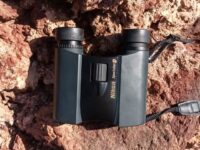The numbers on the binoculars and what they mean can be confusing for the layperson. However, if you want to buy binoculars, it is important to know what do the numbers on binoculars mean and how they affect other binoculars’ parameters.
For example – What Does 10×42 In Binoculars Mean
This refers to magnification and the width of the aperture.
The first number in 10x42 is the magnification of the binoculars. With a 10x magnification (also called Power), the object is seen 10 times larger as with the bare eye. So if the viewed object is in a distance of 1000 yards, the object appears as if it were only 100 yards away. The more magnification, the closer far objects appear.
The second number in 10x42 indicates an objective lens diameter of 42 millimeters. This parameter is also called the entrance pupil. The diameter of the objective is crucial for a number of factors that determine the performance of the binoculars.
What else do these Binoculars Parameters determine?

FOV Field Of View
These numbers are also frequently found on binoculars: 340/1000yd or 340@1000yd or 113 @ 1000m.
This number refers to the Field of View FOV. 
Magnification affects the Field of View
The horizontal width of the image visible in the binoculars is called the field of view. The field of view is given in apparent width of the same, in relation to the true distance, e.g. B. 120 yards per 1000 yards.
A lower magnification results in a much wider field of view, which is better for scanning large areas.
With higher magnification, the field of view becomes less wide, which is better for viewing objects in detail.
A Larger Objective Lens increases Twilight Factor
The objective lens acts as a collecting lens, i.e. it collects incident light and focuses it in an intermediate image. The eyepiece enlarges the intermediate image and enables the observer to look at it.
The larger the diameter of the lens, the more light can be collected, thus the brighter the image will appear.
The objective thus affects the light intensity of the instrument, with binoculars one speaks of Twillgt Factor.
The twilight factor expresses the performance of the binoculars in low light conditions.
It is the square root of the product of magnification and lens diameter. TF=√M Do
In our example from above with the 10×42 binoculars, this calculates
- TF=√10 x 42 = √420
- TF = 20.49
In our example of 10 x 42 binoculars, the twilight factor is 20.5
The figure for binoculars is usually between 5 and 25. The higher the number, the brighter the projected images appear in poor lighting conditions.
The twilight factor alone is not enough to assess the twilight performance of a pair of binoculars; the transmission of the optical glass and its coatings matter, as well as the exit pupil.
Magnification and Objective Size Affects the Exit Pupil
The Exit pupil is the diameter of the projected image that appears in front of the eyepiece. If the observer wants to view the entire projected image, then it is necessary that the observer’s pupil is the correct distance away from the eyepiece ( eye relief).
The Exit pupil can be calculated:
Exit pupil (EP) = Diameter of Objective lens / Magnification of instrument
EP = DObjective / M
With the 10×42 binoculars example as earlier, this calculates:
- EP = 42 mm/10
- EP = 4.2 mm
The exit pupil of our sample 10×42 binoculars is 20.5 millimeters.
The diameter of the exit pupil in binoculars is usually between 2 to 8 mm depending on the parameters of the instrument. The larger the exit pupil, the brighter the image appears. The exit pupil is an important factor for the twilight performance of binoculars.
What Do The Numbers On Binoculars Mean
Binoculars are available in a wide variety of designs and specifications. Be it for general use, bird or nature watching, or hunting, each area of application requires special features and ratings from binoculars. The two main parameters of binoculars are the magnification and the lens diameter. These two values can reveal a lot about binoculars.

